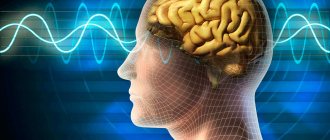In modern society, where a tense atmosphere often reigns, a surge of joy and optimism is considered to be a rare, but quite favorable phenomenon. However, experts in the field of psychotherapy do not think so, because in their opinion, a sharp change in the emotional mood in a positive direction for no apparent reason is due to unfavorable changes in the human brain. Therefore, it is worth delving into the topic in more detail and understanding whether euphoria is a blessing or a state that acts as a harbinger of bad events in the work of certain body systems.
Symptoms
In addition to feeling great with a feeling of comfort and carelessness, euphoria is manifested by a specific facial expression: a meaningless smile, an unfocused gaze, relaxed facial expressions. Contact with such a person can be unproductive: answers after a pause, undeveloped, not always to the point. If you ask to perform any mathematical operation, it will be performed with an error or will take a long time. A person in a state of euphoria is characterized by easy laughter and disinhibition (sexual, food) with a lack of a sense of distance and adherence to etiquette.
Treatment methods
Pathological forms of a euphoric state are usually treated with medications, droppers and psychotherapeutic techniques.
Drug treatment
Treatment of the euphoric state is carried out with the help of tranquilizers, vascular drugs, and antidepressants.
Relaxant
| Drug groups | Influence on aggressive behavior | Examples of funds |
| Normotimics | They relieve sudden mood swings and smooth out the transitions from euphoria to depressive states. Used as symptomatic therapy. | Valpromide, Carbamazelide |
| Tranquilizers | Relaxes and calms, relieves unbalanced behavior. Used for mental forms of euphoria. | Hydroxyzine, Phenazepam |
| Antipsychotic drugs | They are used for mental illnesses that cause a feeling of excessive joy, pleasure and happiness. | Haloperidol, Quetiapine, Clozapine |
| Sedatives with natural ingredients | They relax and calm the nervous system, allowing you to cope with pathological causeless joy. Reduce the symptoms of a euphoric state, relieve hysteria and imbalance. | Persen, Novo-passit, |
| Sedatives with alcohol | Valosedan, Corvalol | |
| Bromine-based sedatives | Adonis Brom, Bromcamphora | |
| Other sedatives | Magnesia, Afobazole | |
| Nootropics | Stimulate blood circulation, improve intellectual abilities and memory. Used for head injuries or problems with blood supply to the brain. | Picamilon, Nootropil, Phenibut |
| Antidepressants | Increases the amount of neurotransmitters in the brain. They help overcome depression, which causes unmotivated delight. | Melipramine, Trizadone, Fluoxetine |
| Diuretics | Cause forced diuresis, help get rid of the euphoric state caused by toxic causes | Diakarb, Trigrim |
| B vitamins | They improve the functioning of the nervous system, help cope with unstable conditions, and smooth out the symptoms of euphoria. | Angiovit, Compligam B, Pentovit |
Read also: How to treat dry cough in an adult?
IV
Important! In case of toxic poisoning caused by abuse of alcoholic beverages or drugs, blood purification using a dropper is used.
The dropper is used for toxic poisoning or simply to remove alcohol from the blood
Under the supervision of a nurse or doctor, the patient is given a mixture of glucose and saline over 30-120 minutes. Once the toxins leave the body, the euphoric state caused by them will also disappear.
In psychiatry
For psychiatrists, euphoria is a symptom that is a signal of trouble in the brain and an indicator of altered consciousness, equivalent to a state of stupor. Characteristic is not only a slowdown and simplification of thinking, but a decrease in receptivity and sensitivity (for example, pain). Euphoria is one of the symptoms characteristic of dementia. One of the types of psychoorganic syndrome or encephalopathy (organic brain damage) is called euphoric. In addition to dementia and psychoorganic syndrome, euphoria can be a symptom of the following psychiatric diseases: psychosis, mania, epilepsy, personality disorders, mental retardation, etc.
What is euphoria?
Euphoria is a feeling of a sudden surge of positive emotions, a literal surge of happiness. The term “euphoria” comes from an ancient Greek expression meaning “well-bearing.” Euphoria is caused by a sharp release of endorphin , the hormone of joy produced by our brain. Most people consider such sudden surges of positive emotions to be a completely natural and normal reaction of the body, which all people experience at one time or another in their lives.
But scientists tend to attribute euphoria that occurs without obvious reasons to a pathology associated with a person’s mental problems. Thus, clinical psychiatrists consider an unreasonably and long-term elevated mood, as well as the complacency associated with it, to be one of the signs of a manic-type mental disorder. They consider this condition to be dangerous to health, since it can lead to emotional burnout.
Separately, it is worth mentioning ecstasy, the addictive highest stage of euphoria. It is the feeling of ecstasy that makes people repeatedly provoke euphoria in themselves in order to experience ecstasy again.
In narcology
Euphoria is the main sign of intoxication or intoxication. In such cases, euphoria consists of a whole series of “sweet” experiences and sensations: a feeling of pleasant bodily well-being (in the form of warmth, air waves throughout the body), mental pleasure and the absence of any tension, it seems that everything around has become clear. If the euphoric state is caused by taking a drug or alcohol, then it is accompanied by neurological changes: coordination disorders and decreased reflexes.
Conditions similar to euphoria: mania, hypomanic state.
Symptoms and signs of euphoria
Science explains the joyful mood that suddenly surges over a person with a list of various physiological processes occurring in the body. Scientists have proven that euphoria is caused by the hormone endorphin, commonly known as the hormone of joy. Euphoria has quite vivid and well-recognized symptoms, which include:
- a feeling of boundless happiness and supreme bliss;
- a complacent and peaceful state;
- under the influence of euphoria, any external influence causes an exclusively positive reaction in a person.
Euphoria is often compared to ecstasy, which is also an extreme aggravation of emotions of the positive spectrum. However, the duration of euphoria significantly exceeds the duration of ecstasy, moreover, ecstasy is an integral part of euphoria, its highest and brightest stage.
In addition to elevated mood and general complacency, the described phenomenon also has a number of noticeable physical manifestations, for example, during euphoria, people’s pulse quickens and blood pressure rises, but the body’s reactions to external stimuli become extremely slow.
Euphoria can simultaneously carry both negative and positive symptoms. Among its negative symptoms are:
- The feeling of being in another reality , called confusion by experts. Under the influence of euphoria, people can experience the effect of “déjà vu,” and if at first it causes them only idle interest, or even does not entail any reaction at all, then over time, “déjà vu” can lead to psychological discomfort, or even to development of paranoia.
- The artificiality of experiences. Often, under the influence of euphoria, people experience unreasonable fear, anxiety, and depression. The point here is that at first they experience only joyful feelings and experiences, but then the positive emotions quickly go away, but the problems they have, on the contrary, remain. Moreover, after a sharp surge of positive emotions, even insignificant problems may seem insoluble, causing long-term depression.
Positive symptoms of euphoria include:
- cheerfulness, quick reaction;
- clarity of consciousness and energy;
- increased activity, an irresistible desire to perform various actions.
The duration of euphoria directly depends on the reason for its development. Thus, euphoria of natural origin lasts a maximum of thirty minutes, but its artificial variety, caused by drugs or alcoholic drinks, can last for several hours.
Causes
The causes and mechanisms for the development of euphoria lie in inhibition of the cerebral cortex and disinhibition (overexcitation) of subcortical structures. This can be caused by both diseases and non-painful conditions:
- Resolving a conflict or significant problem, achieving an important and useful result.
- Love.
- Influence of art: music, literature, images, etc.
- Alcohol intoxication, drug intoxication.
- Infections and poisoning.
- Organic mental disorders, mental retardation.
- Psychoses, schizophrenia spectrum disorders.
- Personality disorders.
Atrophy of the anterior parts of the cerebral cortex (for example, in Pick's disease) leads to chronic euphoria against a background of disinhibition and dementia. An increase in endorphin levels in the blood also causes euphoria.
Feeling a feeling of bliss
What does a person feel in such bliss? How to describe this state? Bliss is the highest degree of pleasure, the feeling of going beyond one's limits. This state is accompanied by liberation from energy clamps. The body has a complete energy shell, and the mind is calm. There are simply not enough words to describe the bliss. You can understand it if you only experience it yourself.
Information from the words of another person will give impetus to the reproduction of bliss by the mind. However, this way cannot achieve true bliss. A person must feel for himself how the body experiences sensory harmony, a reconfiguration of its thinking and emotional perception. The state of ultimate existence cannot be understood. It can be compared to the final stop of your pleasant cruise, the limit when nothing else is needed. The depth of a person affects the level of bliss experienced.
Emotion of delight
An extraordinary state of joy, its strong jump is delight - an emotion with a positive connotation, high intensity of manifestation and a short period of action.
External signs of a person showing an enthusiastic emotion are slightly raised eyebrows (a similar sign with surprise) and radiance, sparkle and joy in the eyes. However, an enthusiastic person smiles a little differently than a joyful, happy one. The smile is wider, stretched to the sides, with a rounded lip line and a noticeably lowered lower jaw.
You can experience a storm of positive manifestations for various reasons. People who delight in a new way and to the fullest can experience pleasure, pleasure, no matter what, including the opinions of others. Enthusiastic people are said to be “mind blown” and are indifferent to what is happening around them. This condition may be the envy of others. And I want to remember the vivid feeling at the cellular level, track it, get used to it in order to enjoy these wonderful moments in the future.
Read our article “Breathing practices: characteristic features of basic techniques.”
Survey
Euphoria is a bright, emotionally expressed state. If it is caused by natural factors, no special diagnosis is required; the person experiences short-term inspiration and excitement, and then his mood becomes normal. You should consult a doctor when unmotivated joy persists for a long time, is replaced by anger and depression, and is accompanied by disinhibited behavior. Patients with such symptoms are examined by psychiatrists, narcologists, and neurologists. Diagnostic methods used:
- Clinical conversation.
Typically, patients are not critical of their own condition. They describe their mood as cheerful and joyful, but do not attribute it to symptoms of illness or intoxication. Their speech is accelerated or slow, emotional, with an abundance of interjections and perseverative repetitions. The doctor receives reliable clinical information from the patient’s relatives. Signs of pathological euphoria are long duration, absence of situational causes, exhaustion of the body, manifested by depression and anger. - Observation.
Patients demonstrate an unreasonable feeling of contentment, carelessness, and serenity. The mood is high, but there is no increase in productive activity, verbosity is unfocused (fragmentary phrases), thinking is accelerated, but unstable. These features are manifested by the inability to maintain a conversation and plan behavior. Facial expressions reflect joy, gestures are extensive. - Psychodiagnostic tests.
In a state of euphoria compensation, special questionnaires and drawing tests can be used for diagnosis. The method of V.V. Boyko “Tendency to Euphoria” is used to identify hypomanic tendencies in the personality structure - SMIL. According to the drawing tests, the level of self-esteem, the presence of impulsiveness, and expansiveness of behavior are determined.
Psychodiagnostic techniques are used to examine patients










